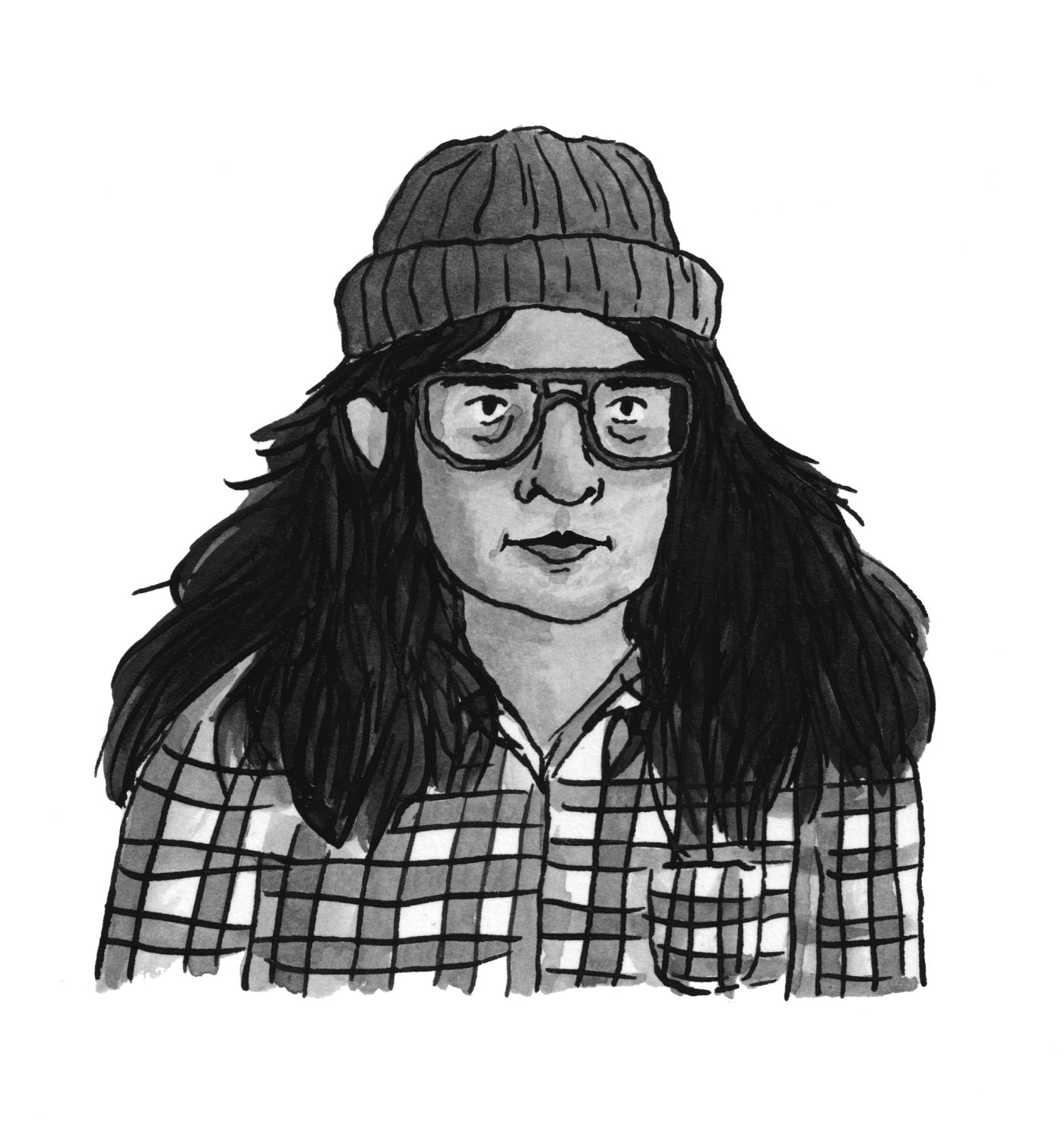
Melissa Mendes’ new book The Weight is a tome. A book that takes place over decades, it is the story of one character, Edie. A long book that is at its best in detailing small, silent moments. Scenes in nature as Edie and other characters live their lives. These quiet scenes of being, people in nature and navigating that sensation, is something that can be traced back to Mendes’ earliest published work — Freddy Stories, her debut graphic novel, self-published with the help of a Xeric Grant after she finished her MFA. In one of that book’s strongest stories, Freddy is forced to spend the summer at an aunt’s in the country. This relationship to the natural world and a conscious placing of her characters in it is an approach to setting and world building that’s been striking. In The Weight Mendes’ artwork is better than its ever been, and we see these elements used in the service of a larger more complex narrative.
Mendes is part of a generation that has been navigating an ever-shifting comics world. She was in one of the first MFA classes at the Center for Cartoon Studies. She received one of the last Xeric Grants. She’s made mini comics and webcomics, has a Patreon, her new book was published by Drawn & Quarterly, and had its book launch at the Massachusetts Museum of Contemporary Art.
Mendes and I have spoken a few times over the years, the first time nearly a decade ago when she had just begun posting pages of this book online. I’m honored to talk with her now that she has completed it. It's as masterful and beautiful and heartbreaking as those early pages promised.
ALEX DUEBEN: I know that The Weight was in part inspired by your grandfather and I wonder if you could talk a little about him and about how he inspired the book
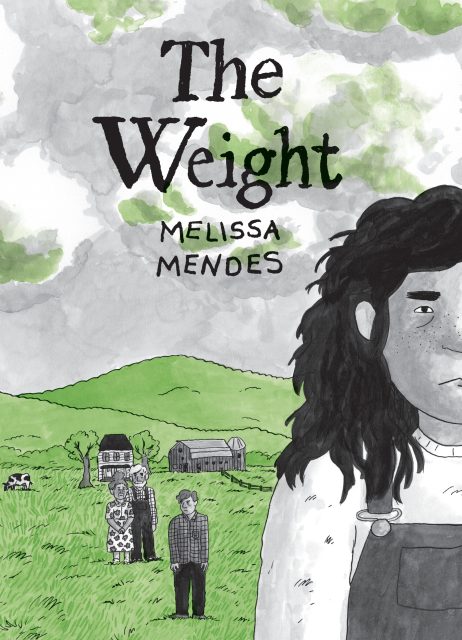 MELISSA MENDES: Sure. I was pretty close to him, my grandpa Jack, maybe because I was the first grandchild. He was my mom’s father. We never lived very near each other but we visited him in Miami quite a bit. He was a big presence. And darkly funny. And he always encouraged my writing. He gave me a John Irving book when I was 15, A Widow for One Year. I was probably too young to really get a lot of it, but I loved it.
MELISSA MENDES: Sure. I was pretty close to him, my grandpa Jack, maybe because I was the first grandchild. He was my mom’s father. We never lived very near each other but we visited him in Miami quite a bit. He was a big presence. And darkly funny. And he always encouraged my writing. He gave me a John Irving book when I was 15, A Widow for One Year. I was probably too young to really get a lot of it, but I loved it.
At some point, I think when he was in his 70s, he took a creative writing class, and he wrote a memoir essay called “A Brief History of My Life”. After he died in 2014 my uncle Mark sent us all copies. My grandpa grew up really poor in rural upstate New York. His family life was rough, and his dad was an abusive alcoholic, but he spent a lot of time at his grandparents’ farm too. I never knew any of this stuff when he was alive. The essay made me feel closer to him, especially because I also grew up in a really rural place. His stories about farm life really resonated with me.
In my grief, I knew I wanted to do something with his essay. At first I started reading through it and separating out each sentence, thinking I'd literally illustrate his writing and that would be the comic. But that didn't feel quite right, so I started to try to figure out how to fictionalize it.
Where did the story as we know it begin for you? Was it with a character, an image?
I think Edie's character actually started to take shape even before my grandpa died. There was a drawing in Denys Wortman’s New York of a young woman at the beach in the 1930s, standing with her hands on her hips and facing the ocean, and she just exuded this strength and confidence. So that stuck with me. And then later, when my grandpa died and I had finished my book Lou and nobody wanted to publish it and I was sort of flailing trying to figure out what to do, I heard an incredible story on the podcast Snap Judgement about a woman named Brenda Clubine, whose husband brutally abused her for years. I don't want to say too much and give away the ending of the book, but her story sort of started a thread between a bunch of things, tying my grandpa's own story of living with an abusive father to this image of a strong woman in the 1930s. And Edie developed from there. Her character design is inspired by a photo that Dorothea Lange took for the Farm Security Administration of a migrant farm worker’s kid in overalls.
I think about your work as being very character-based and your stories always feel more interested in character than in plot. Is this how you think about your own work? Or maybe I should phrase it, is that what interests you?
That rings true to me, definitely. For me the character is always the most important part, and I think you have to know a character deeply for a story to really resonate. I mean, you don't have to know everything about a character before you start; I got to know Edie as I was drawing the book. I think you just need to have a solid connection to them, and think about what it's like to be in their body existing in the setting they are in. You have to really want to spend time with them and get to know them. I never had a plot laid out for Weight, it was basically a rough timeline of events and experiences that I knew she was going to encounter, and she surprised me sometimes with how she dealt with those things.
One reason I ask is because this is a much longer, larger story than your previous books. Did that change how you worked or how you approached the work?
I’ve always sort of worked intuitively, I guess. Like I let storylines and things change, and never have a hard outline. I kind of work from an image or feeling in my head and then it comes out through the lens of the character I am using. I work page by page, basically, with just a vague timeline in my head. And then I let little moments get drawn out, whatever feels right. I never set out to spend five pages on Edie swimming in a pond, it just happens, because those are the moments that are important to me. I want the reader to get a sense of what it's like to be Edie, to be in her body.
And the story did change so much, and constantly. I must have gone into Chuck’s studio at least a dozen times and said “I think I know the ending!”. And then I'd draw a couple more pages and it would change again.
One other aspect in your other work that really comes out in The Weight is the setting. You really take great care in these nature scenes.
Thank you. It's definitely influenced by where I grew up in western Massachusetts, with rolling hills everywhere and farm land and meadows. I also took a lot of inspiration from old Farm security administration photography, and the photography of Walker Evans. I wanted it to feel real, so I wanted to look at actual photos of what it looked like to be poor at that period of time in the rural U.S. … like what furniture they'd have, what would be on the walls, etc.
Were you basing these scenes on particular places?
At some point Chuck and I did drive out to Williamstown, N.Y., where my great-grandparents’ farm was. I didn't know the exact address, but I took lots of pictures of the fields and farmhouses and used those as reference for a lot of the scenes.
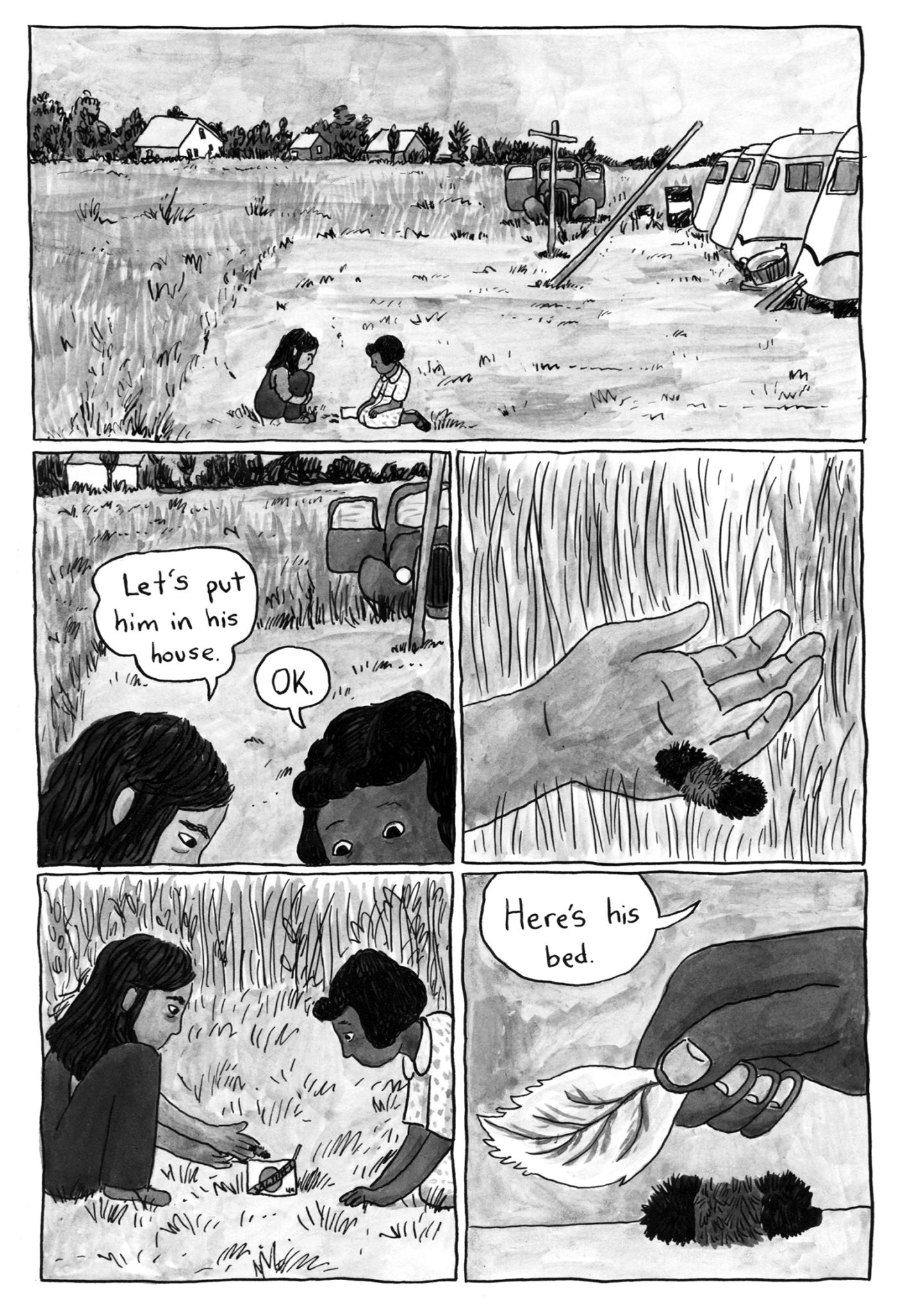
There is a certain timelessness about the story. You don’t make it clear when exactly the story takes place. Was this a conscious decision from the start? Did it become one?
I think I just drew what was important to Edie and her family at the time. Like what would stand out to her in her memories. Sometimes I feel like that's what the book is … Edie’s life how she would remember it. So things like finding a rabbit in a snare that her friends caught, and then burying it, that would stand out in her memories of childhood, rather than world events that she would have been pretty disconnected from. I was talking to my uncle recently about his childhood and this whole big event at their house where they did a nativity scene for the whole town at Christmas … but the thing he remembered the most was how this one chicken ran down the stairs making a funny noise. I love little details like that, and those are the things that stand out to me too. Now that I think about it, that's how my grandpa laid out his memories in his essay as well. So maybe it's genetic.
Did you know from the start that you would use this three-tier grid for the pages? You seem to find a lot of freedom in working that way.
When I was at CCS I read John Stanley's Little Lulu and started using the six-panel grid for my Freddy comics, and that just stuck with me and I've been using it ever since. I think it just works naturally with my pacing. I wanted to not completely restrict myself, so there are parts where I used different sizes of panels, and I tried to just do what felt right. I think that having restrictions can be helpful too, though. Less choices to make and more freedom to just tell the story.
The Weight began as a webcomic and you were serializing a page or two a week. Did that shape how you were telling the story at all? Or was it just distribution?
I don't think it necessarily changed how I was telling the story, but it definitely changed what ended up in the story. It's all influenced by my own experiences over the past 10 years, by what I was watching/reading/listening to, and what was happening in the world around me. Edie grew up with me over the past decade. It would have been a very different story if I'd drawn it faster [laughs]. I was so hard on myself the whole time about how long it was taking me, but in the end maybe it worked out for the better.
I think also having feedback and support from my patrons on Patreon and readers along the way really helped with my motivation. It kept me accountable. I don't know if I could have stayed with this project for that long without them, honestly. Their presence was really validating.
If you had drawn it faster would it have been a more compressed story? Less?
I just mean that if I drew it faster, I wouldn't have all these outside influences of what media I was consuming and what was happening in the world. I would maybe have just been entirely focused on the story I wanted to tell and not letting it grow and change as I drew it.
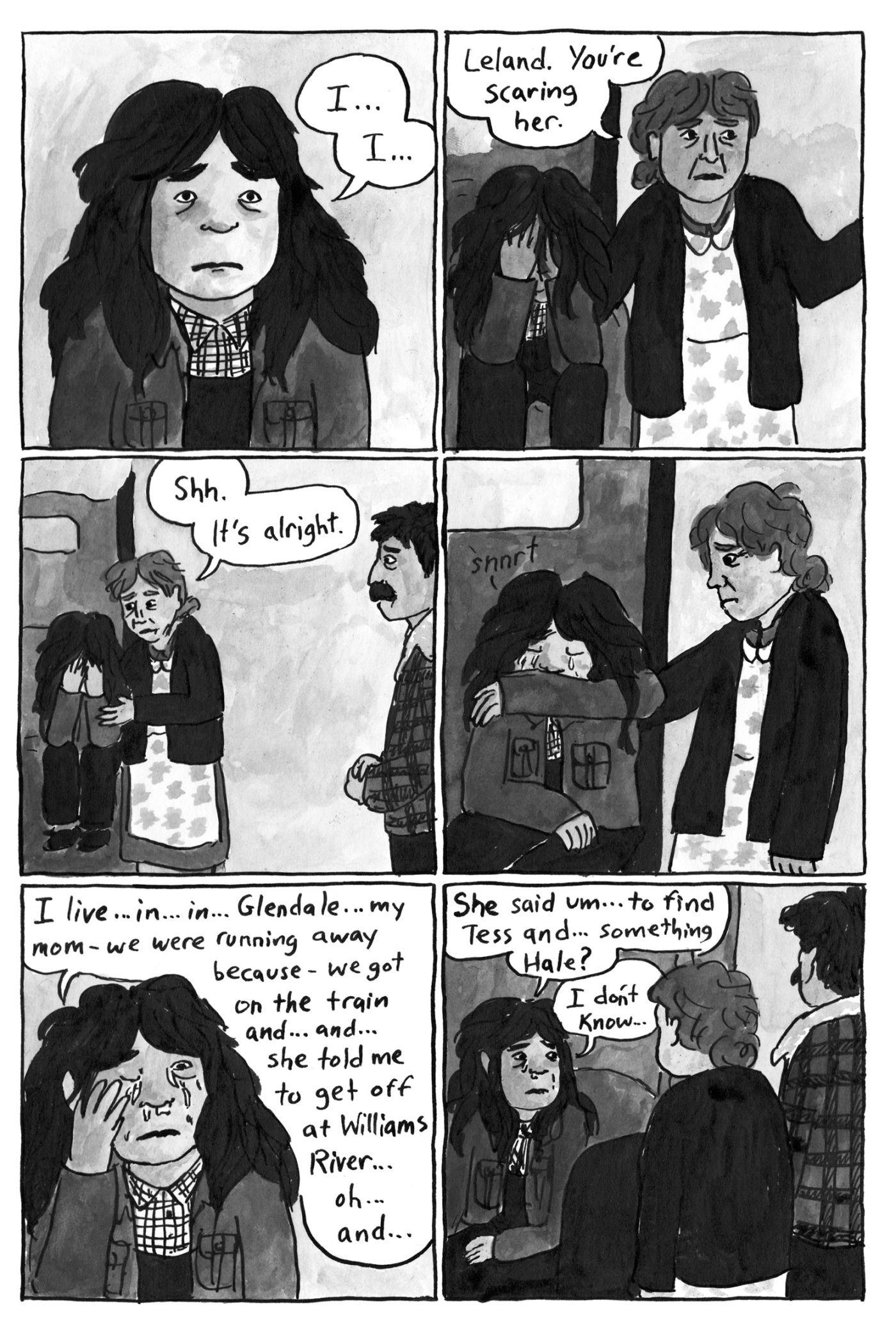
Talk a little about Edie. What was the process from your first idea of her to how she grew on the page over time?
I feel a really deep connection to her, I think because she is me, really. She’s kind of an amalgamation of my and my Grandpa. One of the most surprising things to me about her was her own tendency to use physical violence. I think maybe her violence is my own answer to the abuse perpetrated by her father — and the violence in my own family history. She is fighting back and protecting herself and her mom, but has to contend with the fact that she has this tendency. And this rage. I had a lot of rage as a kid and teenager. I didn't know what to do with it and I would just explode, and then also implode, taking it out on myself. I felt like I was honoring and validating that with Edie’s character a little. Maybe even healing.
I honestly still don't feel like I completely know her though. I'm not sure why. She's her own person, she's figuring out the world and her place in it, and I'm just kind of an observer. I'm watching her live her life.
There’s this through line in your work of these tomboyish figures — Freddy, Bird, Lou, now Edie. Where do you think that comes from?
I have always been a tomboy. Do people still use that term even? I don't know. But I remember at my sixth grade graduation, it was like a really big deal that I wore pants and not a dress. And I got mistaken for a boy, especially when I would cut my hair short. That was slightly traumatizing, I think. When people don't see you as who you know you really are. I've never felt necessarily like I want to be a boy, that’s just what I'm drawn to and I'm more comfortable with. And that comes out in my characters, I guess. They are all me, in a way. Maybe I'm trying to get to know myself through them and be more comfortable with my identity.
So you had this ending — maybe not that image, but that ending — in mind from the start? Or were you originally thinking that it was as much Marian’s story as Edie’s?
The story was always going to be Edie's, and I definitely had that ending in mind the whole time. Well, actually, originally I had planned for the book to span Edie’s entire life from birth to death, and for this ending to happen in the middle. But after getting feedback and nudging from Tom [Devlin], I changed some things about it, and now I feel good about ending it where I did. I realize now that, like in all novels, it's ok for the character to go on living and not write about it. As the writer it's good to know what you think will happen in the future, but you don't have to necessarily tell the reader all of it.
I think of so much of your work as defined by silences. Or maybe the characters are defined by silences? But you really enjoy having these sequences with no dialogue and using them to explore the setting and help define the character
I think the characters move through the world in a similar way to me, as a quiet observer. Having all those silences feels natural to me. I actually used to be incredibly self-conscious about that, worrying that it was boring, like why am I dragging this out so much? Who will want to read this? But I'm starting to realize now that maybe it's one of my strengths, and I should lean into it rather than push it away.
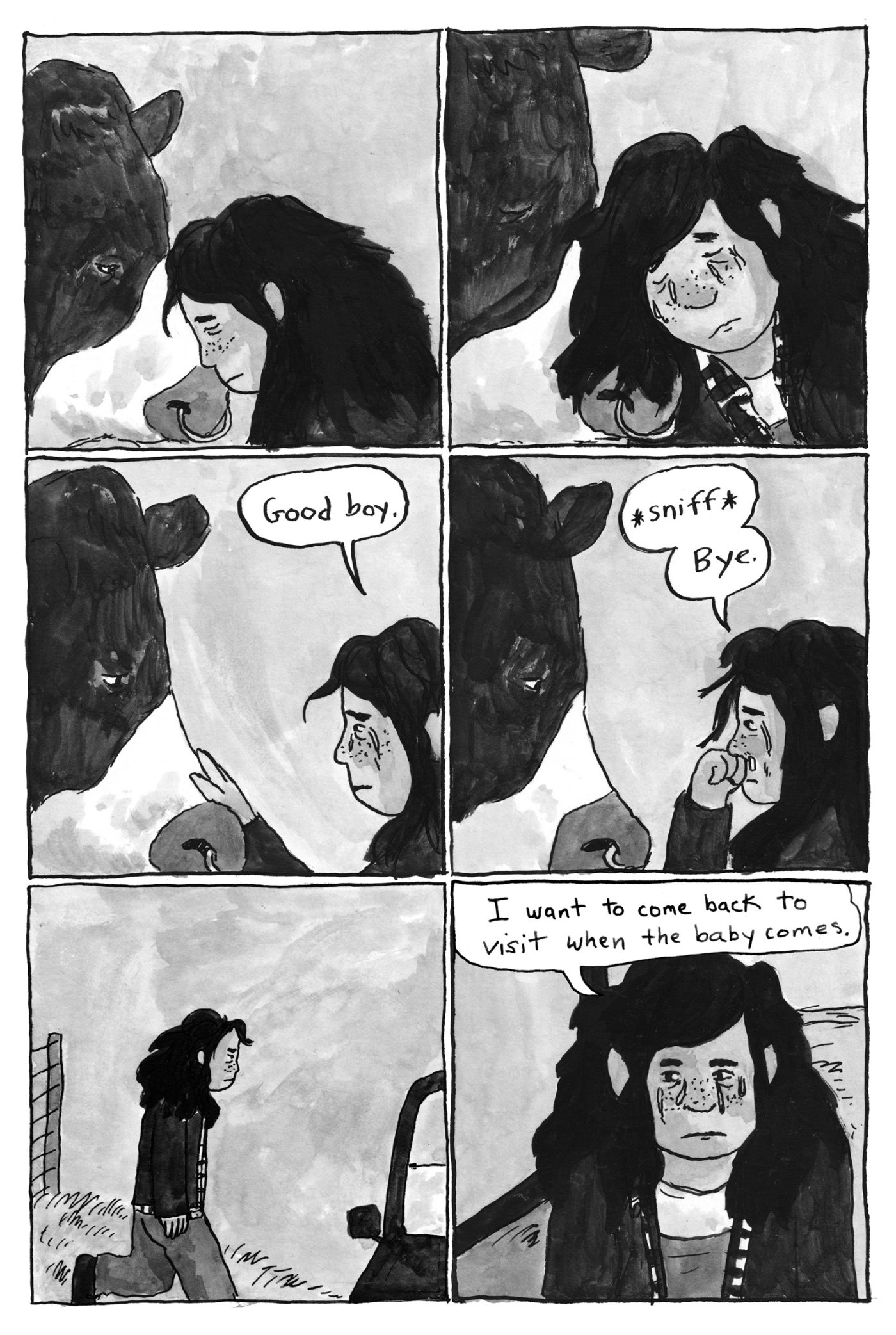
Rereading chapter eight, which is quiet and beautiful, I was surprised by how much dialogue there was, because it’s a chapter shaped by the silences and the wordless sequences more than the dialogue. Maybe some of that is, as I mentioned before, that the characters are defined and shaped by silences.
Tom said something about the book recently that I really liked, that “this is a book that understands what it's like for a body to live in the world.” I think that in real life, there is a lot of silence. A lot of just looking and observing. And I think I wanted the reader to get to know the characters through the silent moments, through how they move their bodies through space, rather than the words they might say or think. And facial expressions come more naturally to me than words sometimes.
I really like that observation, “This is a book that understands what it's like for a body to live in the world.” It is a book that is about physicality and space. Weight, if you will. But talk about the title and why you decided on it. Because it is also the name of a famous song.
The way I came up with the title is a little weird. Actually I think I might have come up with the title before I had a story in mind. I was reeling a little from both my grandpa's death and from trying to pitch my book Lou to publishers and getting rejected, so I was doing that thing where I flailed about trying to figure out what to work on. And I had this idea for a comics anthology that would have vibes similar to Life Magazine. Like true, real-life stories I guess? Not just autobio but journalism too. I don't know. Anyway I was just spending hours in my sketchbook writing different words down that I liked, trying to come up with a title for the magazine. And at one point I wrote down “The Weight” and it felt … significant somehow? Like something different than this anthology I was brainstorming.
And I love the song by The Band, but at the time the story didn't have much to do with the song. That era of music does remind me of spending time with my mom's brothers, and I love them a lot, so it is comforting to me.
I do like the idea of a comics journalism/creative nonfiction magazine. And given the world right now, The Weight seems like a good title.
Yeah, maybe I'll actually end up doing that some day. I had a lot of ideas like that when I was younger. Right now it seems like a lot of work and I'm too tired!!
I’m a little amused that your grandfather gave you a John Irving book. Because I think about a story like Edie’s, which takes place over decades, and these stories that follow a character or a few characters over decades is what he does so well.
Yeah I think Irving definitely has had some influence on me. I was also obsessed with Anne Tyler’s novels when I was a teenager. My mom had them lying around so I would read them constantly, and I love just the complicated family dynamics of her books. She's an incredible storyteller.
My biggest novelist influence is probably John Steinbeck though. The way his novels span generations, the pastoral writing, and I love how deep and well rounded his characters are. I love that he gives time and space and consideration to more marginalized characters who might normally just be in the background. East of Eden is one of my favorite books of all time, and I just read the novella The Red Pony and I can't stop thinking about it. I also read Lonesome Dove by Larry McMurtry a couple of times while drawing The Weight. That's my other favorite book, along with Cruddy by Lynda Barry.
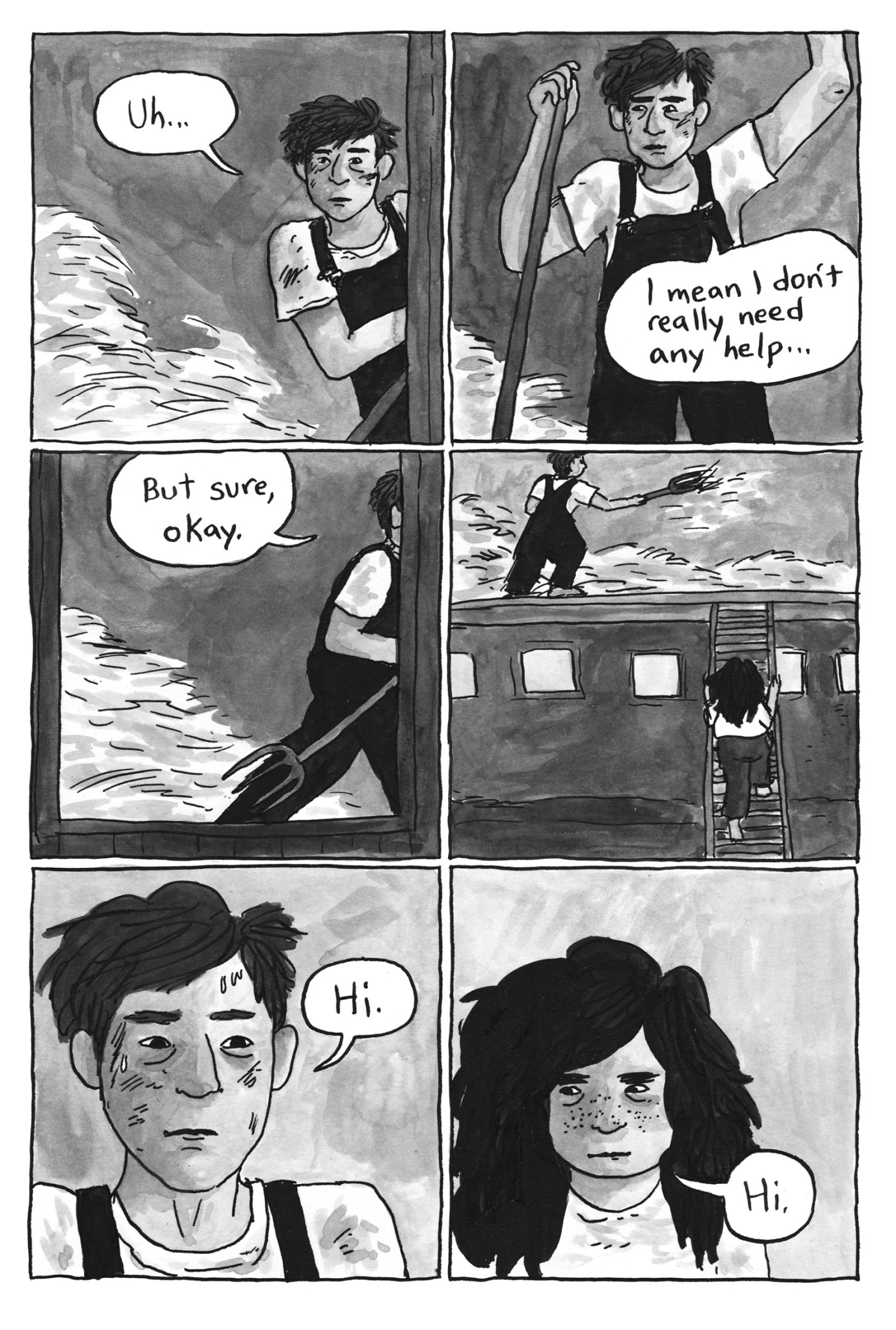
You mentioned CCS and I wanted to talk a little about your start in comics. How did you start making comics and how did you end up going to graduate school for comics?
I was always obsessed with the comics in the newspaper. I devoured all of Calvin and Hobbes as a kid, plus Peanuts, Foxtrot, Zits, For Better or For Worse. I even remember dressing as a cartoonist for a “Job Day” in elementary school. I think I wore an apron for some reason. But I never really drew comics until I got to college. I went to Hampshire College in Amherst, Mass., where you write self-evaluations instead of getting grades, and design your own major.
One time I was having a lot of trouble with a paper for a class, and I asked the professor if I could draw a comic instead of writing an essay. And he said yes! And I think something clicked after that, and I started to realize that I make sense of the world through the combination of words and images. There were barely any people doing comics there at that point. But I was able to do a comic for my senior thesis, and that's where my character Freddy originated, actually.
I found out about CCS through a newspaper clipping someone sent me, and ended up interning there before they had even opened. I think it was 2005. And something clicked then, too … started to learn more and more about the comics community and be exposed to a lot more types of cartooning. I think I realized that maybe I fit in there. So then I flailed around for a couple years after graduating college before I decided to apply for CCS.
I went into CCS thinking I was going to get better at teaching comics. I think that was sort of how I was justifying the money and the time I was about to spend. But being at CCS made me more confident in the idea that I could be a full-time cartoonist, and that that was my actual dream.
Not to get off topic, but I have to ask, what did elementary school age you think that cartoonists dressed like?
I can't remember the full outfit exactly but I think I wore jeans and a T-shirt and an apron. And maybe a beret? I think the apron was denim. Then I had pencils in the apron pocket and behind my ear. Actually now that I think about it, wearing an apron full of pencils while I draw sounds like a good idea. Maybe I'll try it!
I did not know you went to Hampshire, but it’s interesting that was where Freddy came from. Was the character and your approach that we saw in Freddy Stories, there from the start, even if it wasn’t as polished?
When Freddy first appeared she didn't have a name or a voice, really. The first comic I did of her was all silent because I was only doing wordless comics back then. And a ton of cross hatching. My thesis was a book with one panel per page, telling the story of Freddy’s parents going through a divorce (which I went through as a pre-teen). But Freddy herself has always looked pretty much the same. And I think she's still the same person as she was then, she's just been growing and changing with me as I've gotten to know her better and given her a voice. Now I do a four-panel comic about Freddy every week on my Patreon, and they're mostly really silly and funny now. A lot of them are inspired by my niece. There are a lot of fart jokes.
Besides the tomboy characters, I think about the longer story where Freddy has to spend the summer in the country. That idea of nature, of being a body in the world, you can see you starting to puzzle out what that means.
Oh yeah, that's true! I hadn't really thought of that.
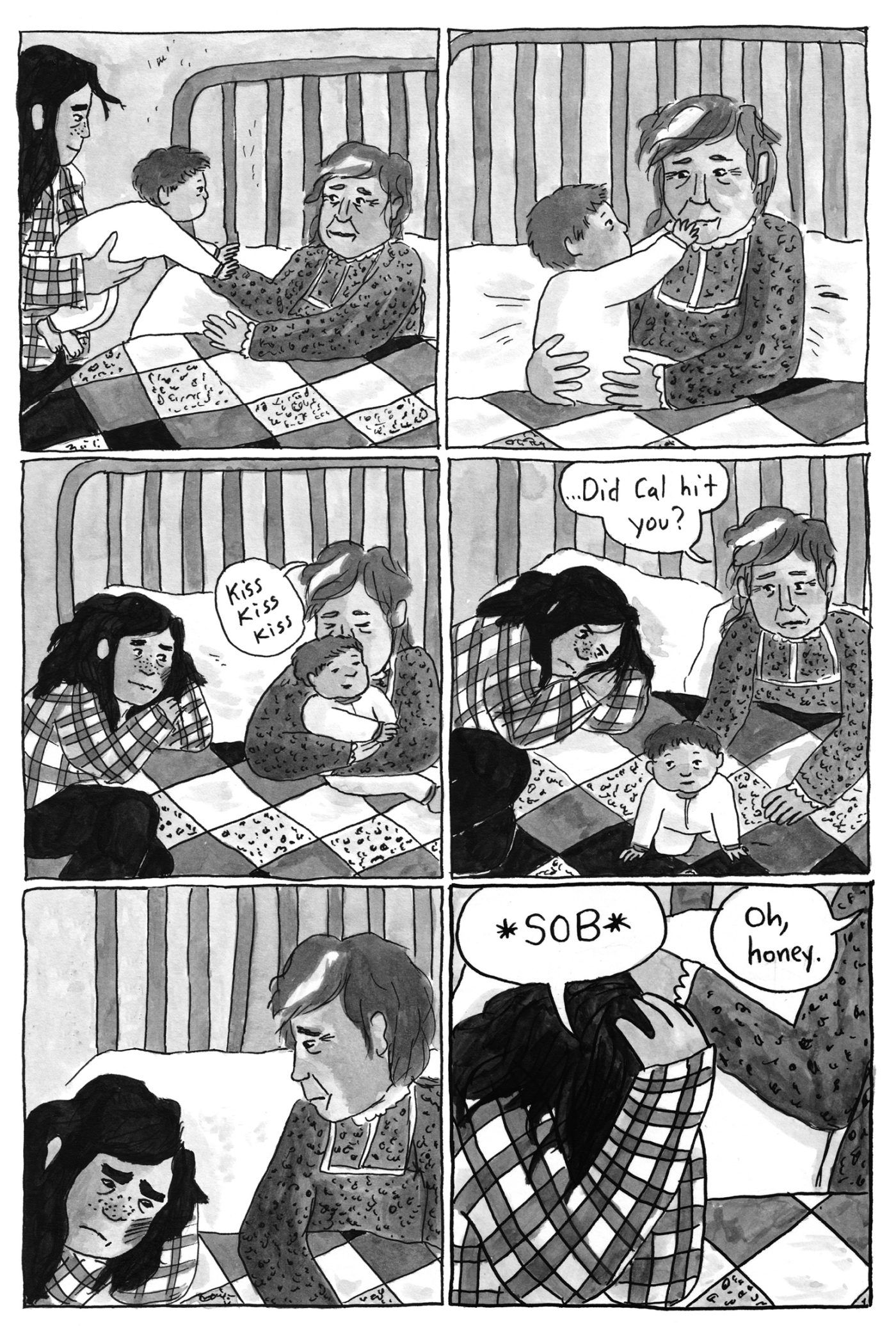
I read somewhere that you were an intern at Mirage. When exactly was that and what did the job involve?
It was the summer after I graduated Hampshire, at their former offices in Northampton, Mass. They had a basement full of all the Ninja Turtles merch ever made, that was so cool to see. And all of the guys there were so nice. Some of them would take me to the local comic book store with them every Wednesday. I remember erasing some pencils on some original pages. Mostly I was working on scanning old art so it could be put on an online archive. I have no idea where that is or if I was any good at it! But it was fun. Another thing I'll always remember is that there was a room full of Peter Laird’s Segways.
Was it at the end of your time at CCS that you applied for a Xeric Grant?
I actually applied for the first time while I was at Mirage Studios. It was probably a conflict of interest because they ran the Xeric Foundation, but for some reason they let me! And I didn't get it that time, obviously. The second time I applied was in 2010, after CCS, when Chuck and I were living in Providence.
How did The Weight end up at Drawn and Quarterly and what has working with them been like?
In 2014 I brought a little preview of the first couple of pages of The Weight to SPX. I handed it out to a lot of people, including Chris Oliveros, and I remember Chris coming up to our table and asking me more about it, and I was like, "holy shit." I interned at D&Q while I was at CCS, and Tom Devlin was my teacher there, so I've been friends with them for a really long time. But they were still always my dream publisher. So when Tom emailed me in 2015 saying they were interested I was so excited. It was a dream come true, really. And I don't know if anyone else would have been so patient with me and The Weight. There were definitely times when life was hard and I didn't think I would ever finish it, but Tom never pushed me too much. Towards the end he was nudging me though, and I'm glad he did actually. It was my first experience getting real editorial feedback (I ended up changing a lot in the last half of the book) and that was rough to take at first, but I really feel like Tom and Lucia’s input helped me make the book stronger.
As far as the editorial feedback that they had, was it more a question of fine-tuning and pacing as opposed to altering the story?
It was more about fleshing out Edie and Cal’s relationship and making the end feel less rushed. I tried to do more of what I had done in the first half, adding more nature scenes and quieter moments.
This isn’t the only thing you’ve done over the past decade, but this is a big project and I hope you’ve been able to celebrate and relax after finishing it. I’m not going to ask what are you working on now, but has doing this made you rethink what you want to do? How you want to work going forward?
Finishing The Weight really freed up something in me, I think. Like a weight was lifted, literally. So I've been doing just sort of little projects here and there, like right now I'm painting one of those signs that you stick your face in for the farm that I grew up next to.
I have a new story/book idea floating around in my head that I've been slowly working on character designs for. I'm taking inspiration from my own life growing up in rural New England in the 1980s/90s for this one. But I haven't actually been able to start it yet and it might be driving me a little crazy, so I think I need to start getting it out and on paper.
I've thought a lot about how I want to do the new book differently from The Weight. I might serialize it on my Patreon chapter by chapter rather than two pages a week. I also want to be freer in my drawings. Like get more cartoony, if that makes sense. And not be so confined by having to get so many things visually accurate. I don't know yet how that will look though.
Finishing the book has given me the confidence that I can finish another one. I know I'm a cartoonist now. And all the positive response from people has made me feel like I did the right thing by taking my time with it. Now that it's all collected I can finally see how hard I really did work. And I don't need to rush to get the next one out. I can slow down and make the book that I want to make.
The post ‘The character is always the most important part’: An interview with Melissa Mendes appeared first on The Comics Journal.

No comments:
Post a Comment